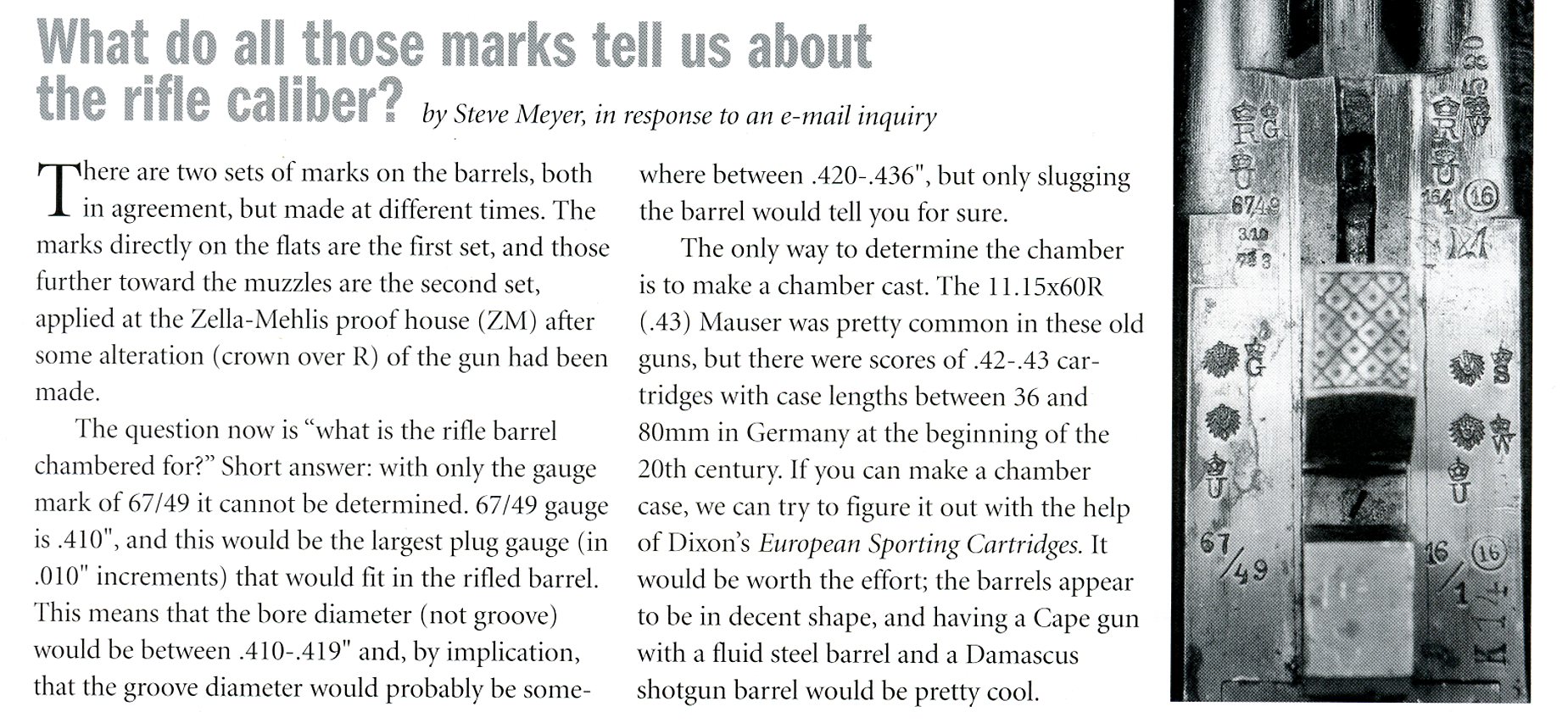|
Introduction to German Hunting Gun IdentificationBy Dietrich Apel
It is not as easy to identify a German made gun as identifying a gun made in the USA, and the following articles explain why. Even the most knowledgeable collectors and gun owners are often scratching their heads and sometimes give up and can only give you an educated guess. The following hints might be of help to you.
The famous first impressions should at best encourage you to not jump to conclusions too early. The term Germanic Guns is used, but in our opinion this is not a well chosen description because what looks like a German gun to you might have been made in other countries, including the United States. When entering the words Germanic Gun into a website search engine, the question comes up “do you mean German gun?” When you enter “Germanic Weapons”, swords that the old Germans used when fighting the army of the Roman Empire come up. We prefer to call a baby by its real name, a gun that is made in Ferlach an Austrian gun, one made in Switzerland a Swiss gun and guns made by a German gunsmith in this country an American made gun.
The inscriptions on the top rib or the barrels might confirm that the gun was made in Germany when the name of a town in Germany follows the first name. When in doubt, enter the town into a web-site search engine and you will usually find some information about the location of the town. The first and last names could be that of a maker, a dealer, a gun factory, a wholesaler, an importer or an exporter. The following articles with the title “Who made all those German Guns” and a “Gun maker -Gunsmith or Dealer?” are well worth reading,
Proof Marks are usually found on the underside of the barrels, and if a gun has German proof marks and was made in 1892 or later, you know that the gun was proof tested in Germany. This is no assurance however, that all components of the guns where made in Germany, The gun making center in Liege in Belgium was known for the good quality of their shotgun barrels that were used by gun makers in other countries. You might want to print out the list of German proof marks that follows for reference when you encounter a German gun.
Additional questions are covered in the articles that follow. The list of German gun makers and dealers in section 5 will get much longer as we find the time to add them to the list. |
|
|
Who made all those German Guns?By Dietrich Apel
We have seen many guns over the years with names not known to us, especially those that were made late in the 19th Century or early in the 20th century. Many times we don’t know whether it is the name of a maker or the name of the seller. Information is very hard to find, and those of you who have tried to research their family history will know of the difficulties.
It was the tradition of the period, that gun shops all over the country would order guns from a maker, mostly in Suhl and Zella-Mehlis and vicinity, and ask him to engrave their name and the name of their town on the gun. It can usually be found on the top rib or on the barrels on both sides of the rib in front of the action.
The same thing was done when guns were ordered by wholesale distributors, exporters or by importers in the United States. Good examples of this are guns marked with the names GECO, AKAH, Kettner in Germany and Charles Daly, Abercrombie & Fitch or Griffin & Howe in the U.S. This custom is still with us. For the most popular and desirable guns, like the “Prussian Dalys” we can usually determine who made the gun. But even this can be difficult.
What can we tell by other markings or features? You first want to look for a maker’s trade mark or initials. If found you can try to find the same one in Section 5, the lists of gun makers and dealers. Then you can study the proof marks that follow which can confirm that the gun was made in Germany, that it was proofed in a certain proof house and the period these proof marks were in use.
The experienced collector can tell by the style of the action or other features, where and by whom the gun was most likely made. Sometimes we can identify makers by the engraving because it is unique like a signature. This identification must be left to the serious collector or engraver with historic interest. We are lucky in that we have found an engraver in Suhl who is also a collector of information about engravers.
So, be patient in trying to find answers to your questions. We are building this archive and get new information all the time. But it is a slow process that will take years and some information will never be found. World War II, the occupation of the eastern part of Germany by the Russians and a Communist Government contributed to the loss of most records in that part of the country. |
|
|
Gun Maker Gunsmith Gun Dealer?By Dietrich Apel
The first gunsmith in Germany and other countries was the village or town blacksmith, and to set himself apart from those who mostly shoed horses, he called himself a gunsmith. As ways were found to mine iron ore, refine it and work with it and turn regular iron into steel, and as more and more iron mining took place, the location where the iron ore, waterpower and wood for smelting the iron were available in abundance, gunsmiths were attracted to these locations. The first available document about Suhl, the former gunmaking center of Germany, informs the reader that the town had iron mines and iron hammers that ran on water power.
This mode of operation lasted for quite a few centuries, but as the so called Industrial Revolution began and took hold in the middle of the 19th. Century, more and more gunmakers moved to these gunmaking centers like Suhl and Zella-Mehlis in Germany, Ferlach in Austria and Liege in Belgium.
When it comes to guns that can unquestionably be classified as antiques, there is usually no doubt that the name on the gun is that of the maker. But on guns made during the 19th Century, things began to change. In GGCA Journal #31 is a beautiful pin fire side-by-side shotgun with two names, one on the barrels and another on the backaction side locks. We still don’t know for sure who made the gun and whether the second name was possibly that of the engraver, the barrel maker or the lock maker.
When we get inquiries about muzzle loading guns or early breech loading guns, our first source of information is usually Der Neue Stöckel by Heer, three books that are written in German and are now out of print. They can perhaps be found at book dealers who deal in used gun related books. When we find the first and last name on a gun in this book, we take it for granted, that he was indeed the maker of the gun. Since the book ends with the year 1900, however, the same man could have made guns after 1900 or found it more and more advisable to do less in his own shop and sell guns by makers in the gunmaking centers. When placing his order he could request that his name will be engraved on the gun or even be inlayed in precious metals.
This is the problem we face when you ask us about the maker of your gun. If the gun was made during the transition period in the mid 1800s, we often can’t be sure. If it is known that a gunmaker by this name was located in a known gun making center, it is likely that he was really a gun maker but there are always exceptions to this rule. As an example we can mention the gunmaker Reeb in the German city Bonn. This town was definitely not a gun making center and we do not know of another gunmaker who was located there, but we now have proof that he was indeed a gunmaker but also had guns made in Suhl, the former gunmaking center of Germany.
So, don’t be too disappointed if you can’t find a definite answer on who made your gun.
An article about gun making centers can be found in About The Guns |
|
|
Proof Mark PrimerA German Proof Mark Primer, 1891-1939
Unraveling the history of a German sporting gun or rifle is often a difficult proposition. With the exception of a few larger makers like J.P.Sauer, Merkel and Krieghoff, most records were lost during the wars and only the guns themselves offer testimony to the history, workmanship and artistry of German gunsmiths.
Fortunately, one source remains to us, and that is the marks on the guns themselves. Beginning with the first German proof law that came into effect in the early 1890s, all sporting firearms produced in Germany were required to pass rigorous strength and safety tests at a government regulated proof house. Over the years, German proof laws, like those of other European countries, were revised to cover changes in gunpowder, materials and design. Changes in proof law and the prescribed marks can be very helpful in establishing the date of manufacture, chambering and originality.
I won’t attempt to cover the all ins and outs of German proof law, but there are a few bits useful for dating that frequently come in handy.
Guns and rifles built in Germany and the German principalities before the 1890s typically did not carry proof marks, but the 1891 proof law “grandfathered” these arms by mandating that they be submitted to the proof house and marked with a crown-over-V, the V standing for vorrat or “on hand”. Any German gun or rifle carrying a crown-over-V dates to 1891 or earlier. Marks showing crowns over the letters B, U, (proof approved); G (rifled barrel), S (smoothbore) and W (choked barrel) span the period from the first German proof law of 1891 until 1939, but there are usually other marks present that can greatly narrow the date range. See the accompanying tables.
Rifle barrels marked with only an indication of powder charge and bullet type in the style shown
below date to 1912 or before: 2,67 g GBP St m G.
These marks show 2,67 grams of Gewehr Blättchen Pulver (rifle flake powder) and Stahl-mantel Geschoss (steel jacketed bullet). Other possible types are “K m G” for Kupfer-mantel Geschoss (copper jacket) and “Bl G” for Blei Geschoss (plain lead bullet).
After 1912 marks were changed to show just bullet type and bullet weight as in: St m G 12 g, usually accompanied with a crown-over-N or the word Nitro, specifying smokeless powder.
Shotgun barrels of this era are sometimes marked with a powder charge over a shot weight, but the style of those marks didn’t change markedly over time. Note, however, that some will be marked with the high-pressure proof load, while others will be marked with the standard service load. Shotgun barrels will also be marked with the gauge designation in a circle and, unless they are specifically stamped otherwise, will be chambered for 65mm (2-9/16 inch) long shells. Very often there will be a second gauge mark of the form 16/1 that indicates more closely the exact bore diameter. These marks follow the British system of gauge subdivision and can be useful in determining whether the bores have been honed since they were proof tested.
As an interesting sidelight, I have seen more than one German double rifle advertised bearing crown-over-W marks on the underside of the barrels. A closer inspection revealed that their rifled barrels had been sleeved into the shotgun barrels or block and they were in no way original, or perhaps not even safe. Caveat emptor!
The most frustrating but perhaps the most useful marks of the 1891-1939 era are the various sets with just numbers present. The two most common sets of
numbers applied were bore dimensions and actual proof dates.
Rifles from later in this era are sometimes stamped with a bore (not groove) diameter in millimeters, the most common being 8,8mm for one of the 9.3mm cartridges and 7.7mm for one of the many 8mm cartridges. Some rifles will also have chamber length marked along with bore diameter.
Many earlier rifles will be found with numbers indicating the “gauge” (number of bore-sized round lead balls to the pound) diameter of the bore (not groove diameter).
For instance, a number in the 95-105 range would indicate a bore diameter near .360″ and hence likely to be a 9.3mm chambering of some kind, while a number in the 170s would indicate an 8mm of some kind. I’ve even seen rifles marked with a pair of gauge marks that calculated so close to the actual bore and groove dimensions it was astonishing!
There were several commonly used rifle gauge marks such as 172.28, 156.14 and 141.95 that correspond to 0.010” increments starting at 0.300”and getting larger that followed British conventions. Very often this style gauge mark will be of the form 172/28 rather than with a decimal point or comma.
Unfortunately, with German rifle barrels of this vintage, it is nearly always necessary to make a chamber cast to determine the actual chambering and bore dimensions. Be safe by being certain!
The other set of numeric marks often found on both rifles and shotguns is the actual date of proof. The style of these numbers can easily be confused with the gauge markings described above, so be aware that both possibilities exist. Typical date codes will be three or four digits signifying month and year, as in 513 for May 1913, or 1127 for November of 1927.
Sometimes there will be a dot or slash between the month and year, but most often they are just run together. Often the date code is above a line, with another number below the line. The number below the line is that gun’s actual entry number in the proof house records for that month and year.All of the preceding notwithstanding, keep in mind that there is a great deal of variation in proof marks of German guns and entire books have been written on the subject of proofs. One of the best is Gerhard Wirnsberger’s The Standard Directory of Proof Marks, which was available from the GGCA bookshelf, but is unfortunately no longer in print.. With so little information yet discovered about so many German makers, a working knowledge of proof marks can be your guide to the hidden histories of German sporting arms.
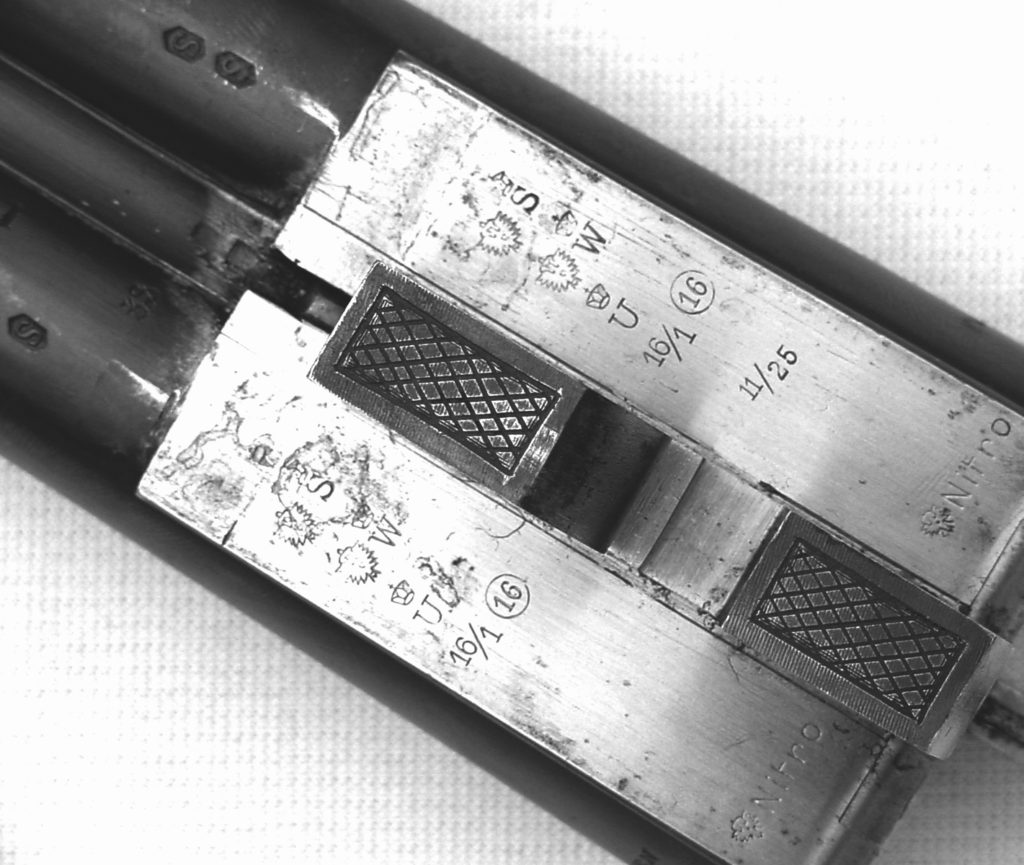
This is a typical 16 gauge of the period between 1912 and 1939. Marks visible are crown-over-U (final proof) and eagle-crown-over-S (smoothbore) and –W (choked). The 16-in-a-circle indicates the nominal gauge of the shotgun and the 16/1 shows that the actual diameter of the bores was between .662” and .669”. The eagle-Nitro mark shows that the gun was proof tested with smokeless powder and the 11/25 mark is the proof date of November 1925.
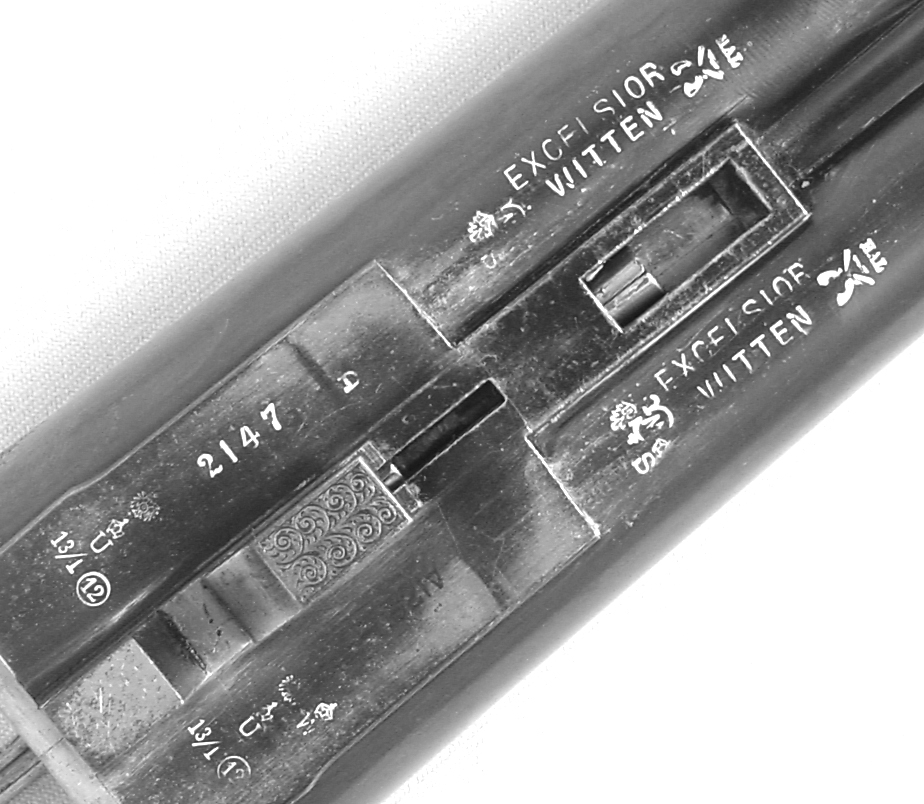
Here we have a 12 gauge that lacks smokeless proof marks and therefore probably dates to between 1891 and 1912. The U, S and W marks are present as in picture 1 and the actual bore diameter given by the 13/1 mark was between .719” and .729” at the time of proof. The barrel steel is clearly marked as “Witten Excelsior” and there is an additional mark on both barrels of crossed pistols with the initials HAL. H.A. Lindner was a prestigious gun and barrel maker of the late 19th and early 20th century whose Prussian Daly guns are the most desired by collectors.
|
|
|
|
|
|
|
Proof Mark Overview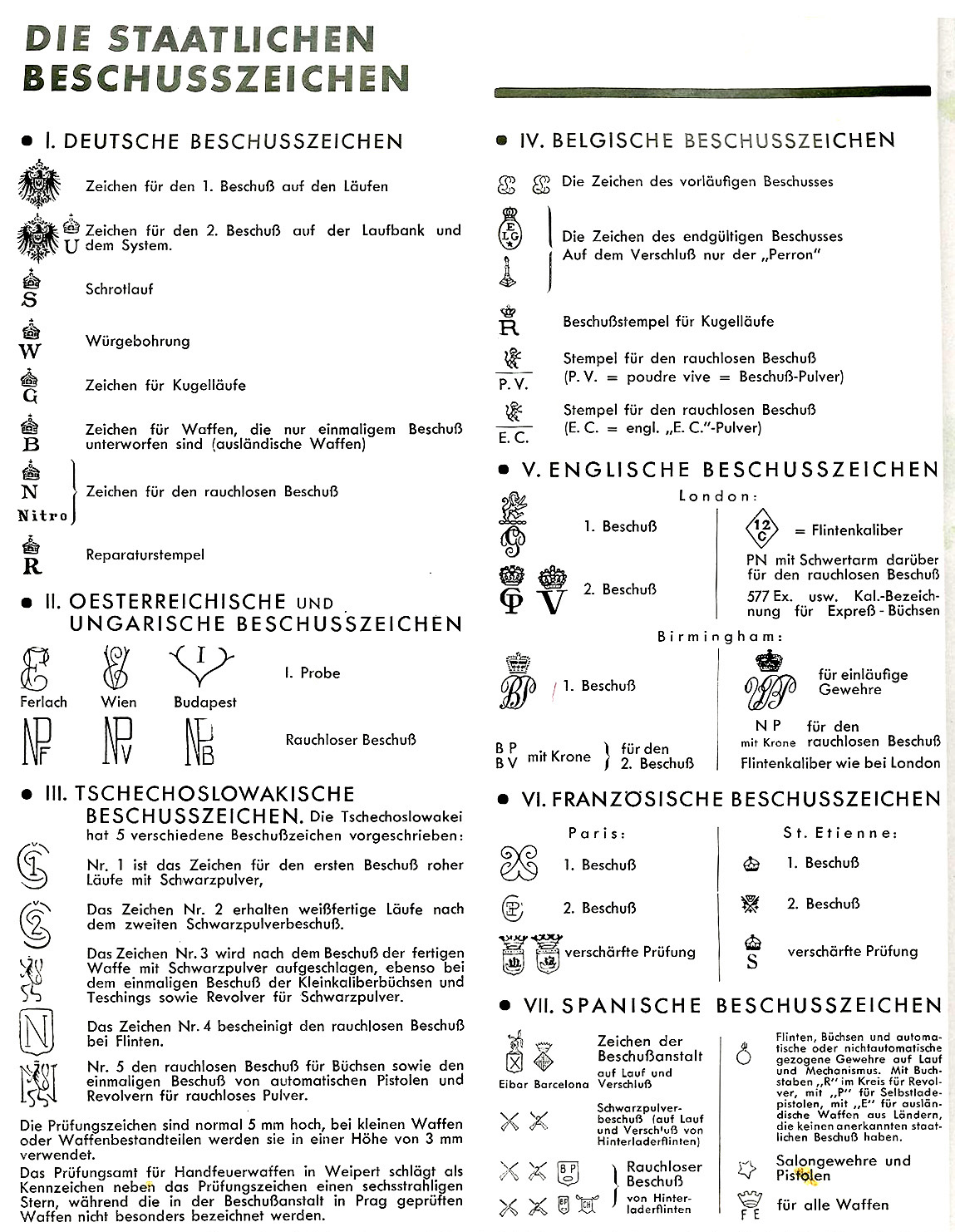 |
|
|
Austrian Proof Marks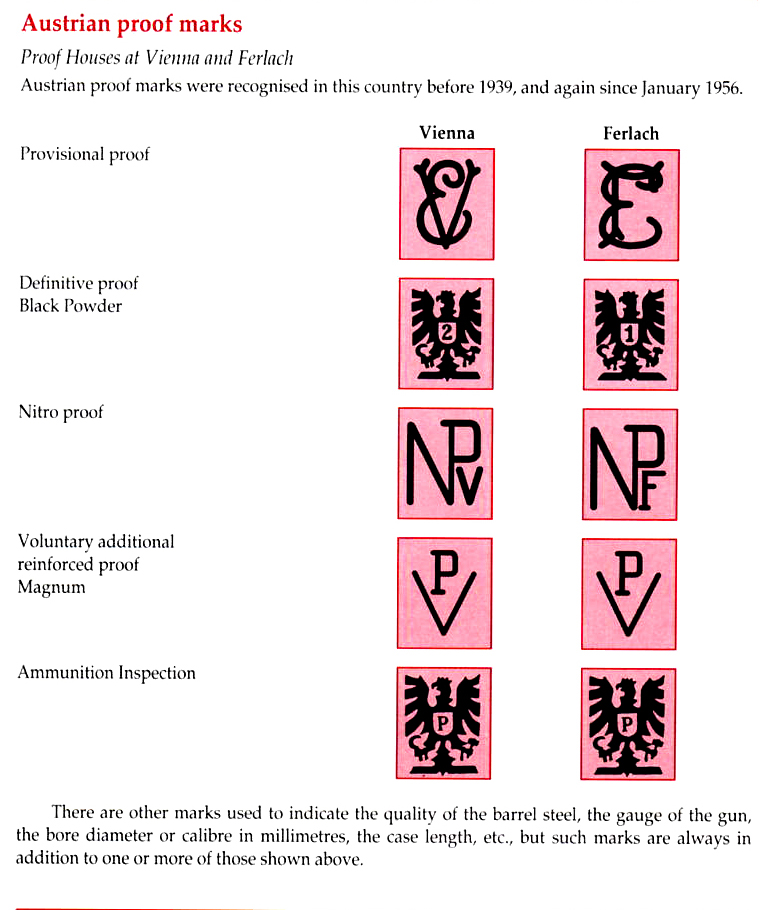 |
|
|
|
|
|
|
Steel Makers & Craftsmens Marks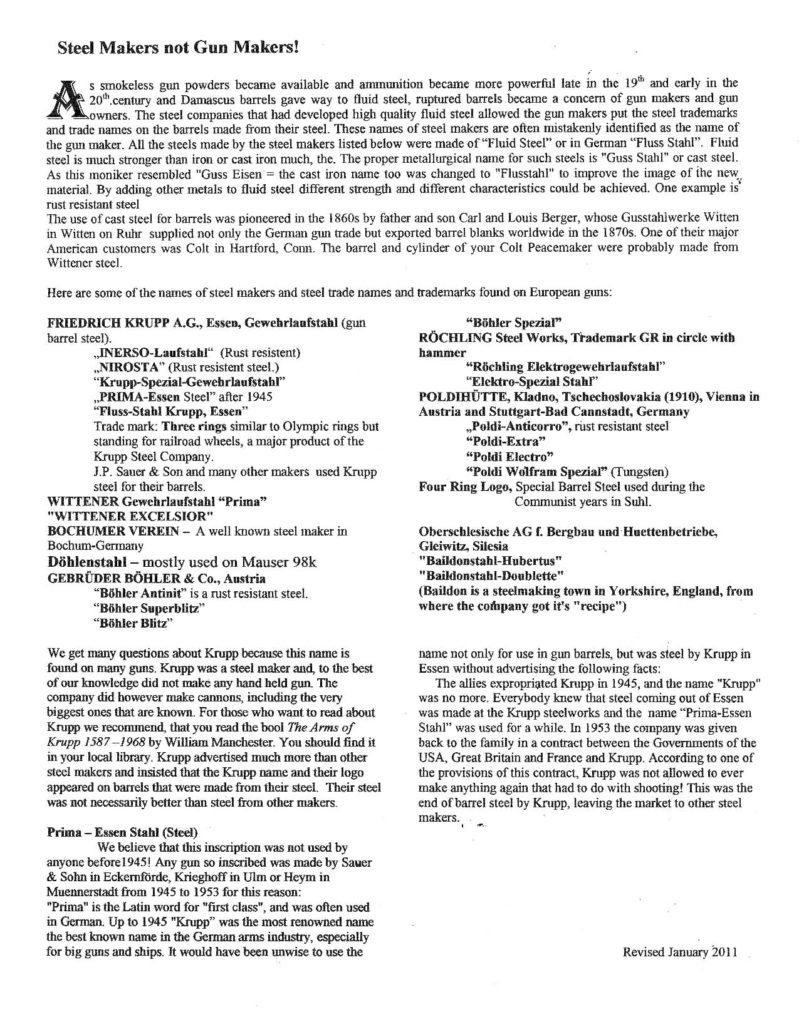
All those tiny marks… By Axel Eichendorff
Many times collectors, upon scrutinizing their European guns, find small marks, most of the time some letters in any sort of script, sometimes surrounded by circles, rectangles and so on. Obviously they are not part of the proof marks or known registered trade marks. Instead, they are individual stamps by individual craftsmen like barrel makers, actioners and other specialists working in the gun trade. Most serious collectors desperately try to find out which person stands behind those tiny letters, but in most cases this proves to be very difficult. Remember: “Who made what for whom?” is one of the best kept secrets of the European gun trade!
Take; for instance the famous “Gunmaker Lindner of Suhl”. He is famous in America because many of the finest German guns sold by Charles Daly are signed with his name or trademark, but his name is virtually unknown in Germany or even in Suhl, except to local historians, who merely know his address and life span. Lindner probably never made a complete gun himself, but he employed a few good men and farmed out the work to make guns to his or Chas. Daly’s specifications to the finest craftsmen working in the Suhl gun trade.
Of course he wanted those craftsmen to mark their work in some way so that he could track work not meeting the prescribed standards, but after he had accepted a gun for export, the purpose of those markings ended! Lindner most likely was not interested in letting anyone else, especially not Charles Daly, know who actually made those fine guns he provided!
This practice does not apply to Lindner alone, but this was the way the European gun trade in Suhl, Birmingham, Liege, Ferlach and so on worked. Remember all those misrepresented “Guild Guns”, made by the trade for the countless gun dealers, with a space on the top rib left blank to bear the dealer’s name? If that dealer did not bother to have his name engraved, the gun remained nameless, even if actually made by famous makers.
Russel Wilkins of Holland & Holland in London once reported that, on visiting the Birmingham gun quarters in the 1960s, that he met a craftsman who occupied an attic accessible only through a trapdoor, who made nothing but the trigger guards for all the British gun makers. Or, as I found out 30 years ago, all the scope mounts used on Austrian guns made in Ferlach, were made, fitted and mounted by a single specialized shop in town. For these special markings were not necessary. As you see by now, those tiny marks served only as the communication between participants of the gun trade. Their purpose was more to obscure relations to outsiders than to publish them. Some craftsmen were using different stamps for their own work and work done for others. Other stamps were used by several men over time. Those who look for serious documentation will not spend much time on these marks anymore, because they were neither registered nor documented otherwise. Relating one of them to a certain man is often pure speculation or guesswork, and that is not always satisfactory. |
|
|
Guild Guns?By Dietrich Apel
German Guild Guns – What are they?
There is no such thing as a German Guild Gun!
When those who claim to know a lot about German guns encounter a gun that does not have a maker’s name on it, they often call it a Guild Gun. This sounds a whole lot better than admitting that they don’t know who made it.
German craftsmen belong to Guilds even today and have for hundreds of years. Guilds were initially sponsored by the reigning potentate in a certain region for the promotion of good craftsmanship that gave buyers a certain guarantee that they were dealing with knowledgeable professionals that were well trained. The Guilds established apprenticeships that had to be served under a master for a certain number of years. The Lehrling (apprentice) had to present a sample of his work to a group of Meister (masters) who would also question him. If they approved of what they saw and heard, the apprentice became a Geselle(journeyman). After working for five years and successfully completing part-time courses in a technical school, he could present his Meisterstück (masterpiece) to another group of masters who could then bestow on him the title Meister. Within the Guilds were groups of the different gun making occupations, likeActioners, Stock Makers, Lock Makers, Engravers, etc.
Most of the bigger gun factories had special departments for training the apprentices, but it was still up to the Guild Masters to do the final testing and giving the final approval. These Guild titles and positions do not tell us anything about the business they worked in. They could work on their own in a one man shop or in a factory with hundreds of craftsmen. Even today every gun shop or gun store must be owned by a master gunsmith or a master gunsmith must be employed. And there are no exceptions to these rules!
So, there is no such thing as a “Guild Gun” and there was formerly no law that required that every gun had to have the name of the maker on it. As a matter of fact, many guns were ordered by dealers in big cities or smaller towns from a gun maker in a gun making center like Suhl, with the specific request to engrave the name of the retail dealer on the gun. Engravers were formerly not allowed to sign their work. Fortunately, this is now changing in Germany also.
You may now better understand that even those who know a lot about German or Austrian guns often can’t identify the maker. Some just try to make you happy and call it a “Guild Gun”. A better name for all these unmarked guns, if needed, might be “Trade Gun”. Most German guns are of very good quality, but there are always exceptions to the rule and the proof marks might tell us that a gun was sold in Germany but made in Belgium. Let the buyer beware and get advice from those who really know! But they are hard to find and they will readily admit that they know very little. |
|
|
|
|
Gun InscriptionsBy Dietrich Apel
German Gun Inscriptions and related terms
| DRGM (Deutsches Reichs Gebrauchs Muster) |
Registration of an invention with less protection than a patent would give. |
|
|
| DRP (Deutsches Reichs Patent) |
The Patent is protected. |
| Drilling – Dreiläufer |
Three barrel gun |
| Fluss Stahl |
Fluid Steel |
| GmbH (Gesellschaft mit begrenzter Haftung) |
Corporation (with linited liability) |
| Graf |
Duke – Count – Earl |
| Hof |
Court |
| Hoflieferant |
Purveyor to the Court |
| Hofbüchsenmacher |
Gunsmith to the Court |
| Inh. – Inhaber |
Owner |
| Kaliber |
Caliber |
| Kaiser |
Emperor |
| Kipplauf Guns |
Break-open guns |
| König |
King |
| Königlicher (Kaiserlicher) Hofbüchsenmacher |
Gunsmith to the Royal (Emperor’s) Court |
| Patent |
Patent |
| Seine (Ihre) Durchlaucht |
His Serene Highness |
| Seine (Ihre) Königliche (Kaiserliche) Hoheit |
His Royal (Imperial) Highness |
| Sicher (Gesichert)(S) |
Safe |
| Scope – h (hoch/höher=higher, t(tief/tiefer) |
Zielfernrohr |
| r (rechts)=r (right), l (links)=l (left) |
|
| Vierling – Vierläufer |
Four Barrel Gun |
| Villa |
Villa, Estate, Mansion, Manor |
| Waffen-Fabrikant |
Gunmaker |
The titles in front of the names were given to reputable businesses for payment of a fee, but did not necessarily relate to the quality or the make of their guns.
Information about proof marks and production marks can be found in other articles. |
|
|
Patent Markings
DRGM – DRP – DRP angemeldet – D.R.W.Z.
D.R.P
Deutsches Reichs Patent
The German word Patent has the same meaning as the English word Patent. The patent records still exist and can be found by the patent number found on the gun or by the gun maker’s name.
Patent angemeldet or DRP angemeldet means Patent applied for.
D.R.G.M – Deutsches Reichs Gebrauchs Muster can be understood best as a pre-patent idea or invention that was submitted to the German Patent Office. It could have been hand written and hand drawn to show what the idea looked like without having engineering drawings submitted along with a patent attorney’s long explanation about the idea or invention. Some people have called it a poor man’s patent because it was very inexpensive to get exclusive rights for a very limited time of an idea or invention. If it proved to be a good idea or product, the person or company had then the opportunity to apply for a patent later on. The DRGM records no longer exist or can’t be found.
D.R.W.Z Deutsches Reichs Waren Zeichen is a Registered Trade Mark of a company but can also be for a certain model. The available trade marks are following. |
|
|
|
|
|
